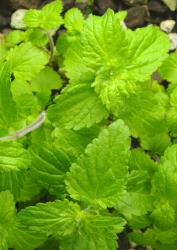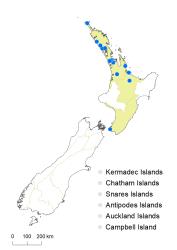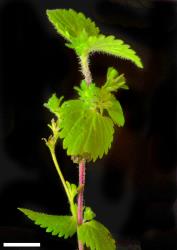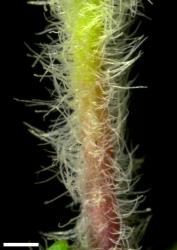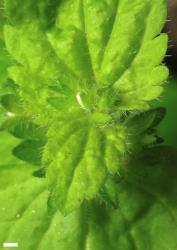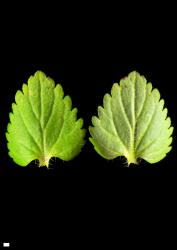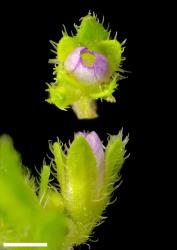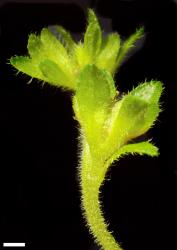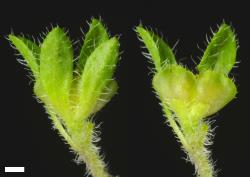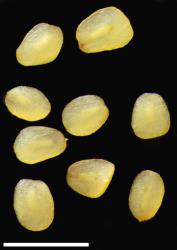Annual herb to 0.35 m tall. Stems decumbent to erect, eglandular-pubescent; hairs uniform or weakly bifarious. Leaf bud indistinct; leaves separating while very small, opposite-decussate, erecto-patent to spreading; lamina thin, usually deltoid or sometimes ovate, 4–45 mm long, 3–35 mm wide, dull green above, pale green beneath; veins 3–5 from base; surfaces with scattered short, tapering hairs, more dense along veins beneath; margin ciliate, often sparsely, serrate to crenate-serrate; teeth in 4–16 pairs; apex acute or sub-acute, rarely obtuse; base truncate to sub-cordate; petiole 2–10 mm long, the upper shorter than the lower ones. Inflorescence a lateral raceme, but very short and appearing like a sessile flower or small cluster at flowering, elongating to 50–175 mm long at fruiting; flowers crowded, 5–20, all bisexual; bracts alternate, linear to oblanceolate, > pedicels; pedicels erect to erecto-patent, 0.5–1.0 mm long, eglandular-hairy all around. Calyx lobes 4, sub-acute to acute, 1.2–1.5 mm long at flowering, expanding to 2.5–3.5 mm long at fruiting, equal to sub-equal, eglandular-hairy. Corolla 1.3–1.5 mm diameter; tube white, 0.3–0.4 mm long, < calyx, glabrous; lobes 4, white to pale purplish or pink, erect and not opening, unequal, elliptic to ovate, 0.8–1.2 mm long, obtuse to rounded; nectar guides absent. Stamen filaments white, 0.3–0.4 mm long; anthers white or cream. Style glabrous, 0.2–0.3 mm long. Capsules angustiseptate, broadly obcordate, eglandular-ciliate, 2.2–2.8 mm long, 3.0–4.5 mm at widest point. Seeds ellipsoid, flattened, smooth, straw-yellow, 0.6–0.7 mm long.
Veronica javanica is very distinctive. The plants have deltoid, toothed, bright green leaves, but their most diagnostic features are the tiny cleistogamous flowers, which look like small, pale scales among the apical leaves, and the way the lateral inflorescence is compact and clustered at flowering but elongates at fruiting. The broad capsules are obcordate with straight sides in the lower half and a distinctly notched apex with rounded ciliate lobes and a very short, persistent style. V. chamaedrys plants have similar leaves, but they are dull and more greyish- green, with blunter teeth, their flowers are large and blue, and open fully, inflorescences elongate before flowers open on pedicels that are longer than the bracts at flowering, and they have much longer stamen filaments and styles. In New Zealand, V. chamaedrys plants do not set fruit.
V. arvensis plants have small flowers, but these are deep blue, rarely white, and open fully, except in cold weather. V. peregrina plants have small, white flowers that often do not open, but all their parts are glabrous.
The leaves and growth form of small plants of Stachys arvensis can closely resemble V. javanica plants, but their flowers are larger, with a five-toothed tubular calyx, longer (6–7 mm) corolla tubes, and a two-lipped, five-lobed corolla limb. Stachys fruits are small nutlets, and the flowers are held in cymose axillary clusters.
North Island: Northland, Auckland (as far south as about Hamilton), Taranaki (Lake Mangamahoe), Wellington (Otari). Chatham Is. V. javanica is widespread in the tropics of Africa, Asia, and America. It is probably still expanding its range in New Zealand.
Gardens and waste land, often associated with revegetation and new plantings from plant nurseries. Recorded elevations range from 2 to 300 m.
Wellington City Council (2007). Voucher WELT SP86054, P.J. Garnock-Jones 2621, Otari, Wellington.
Flowers: all year; fruits: September–June, probably persisting all year.
2n = 16 based on overseas records (Albach et al. 2008).
The phylogenetic position of V. javanica is uncertain and so far it has not been assigned to a subgenus in the new classification of Albach et al. (2004) and Albach & Meudt (2010).
V. javanica appears to have been introduced to New Zealand with tropical produce, perhaps either in pineapple imports or in imported materials used in potting mixes (Popay et al. 2008).
V. javanica capsules have thin walls and open quickly when wet (Pufal et al. 2010).



